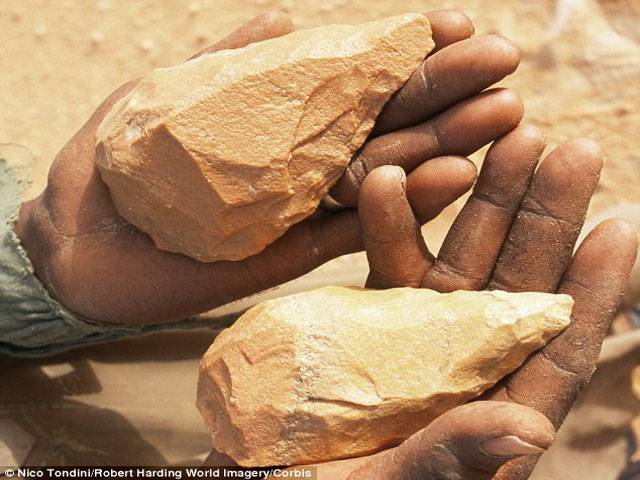MOL
CALIFORNIA
The first conversation between our ancestors was about DIY and likely took place between 2.5 to 1.8 million years ago.
This is according to an international study which found stone tool-making drove the evolution of language among our human ancestors in the African savannah. It suggests communication among our earliest ancestors may have been more complex than previously thought, and that tool-making helped drive evolution.
‘Tool-making created the evolutionary advantage necessary for the development of modern human communication and teaching,’ said Dr Thomas Morgan, lead author of the study at the University of California, Berkeley. ‘Our data show this process was ongoing two and a half million years ago, which allows us to consider a very drawn-out and gradual evolution of the modern human capacity for language and suggests simple ‘proto-languages’ might be older than we previously thought.’
The researchers, who included scientists at the University of Liverpool and St Andrews, arrived at their conclusions by conducting a series of experiments in teaching students the art of ‘Oldowan stone-knapping’. This is when butchering ‘flakes’ are created by hammering a hard rock against certain volcanic or glassy rocks, like basalt or flint.
Oldowan stone-knapping dates back to the Lower Paleolithic period in eastern Africa, and remained largely unchanged for 700,000 years until more sophisticated Acheulean hand-axes and cleavers were developed. Stone-knapping was practiced by some of our earliest ancestors, such as Homo habilis and the even older Australopithecus garhi, who walked on two legs, but whose facial features and brain size were closer to those of apes.
In testing five different ways to convey Oldowan stone-knapping skills to more than 180 college students, the researchers found that the demonstration that used spoken communication – versus imitation, non-verbal presentations or gestures – yielded the highest volume and quality of flakes.
To measure the rate of transmission of the ancient butchery technology, and establish whether more complex communication such as language would get the best results, study volunteers were divided into five- or 10-member ‘learning chains.’
The head of the chain received a knapping demonstration, the raw materials and five minutes to try their hand at it. That person then showed it to the next person in the chain, who in turn showed the next person, and so on. Their competence picked up significantly with verbal instruction. Dr Morgan explained: ‘If someone is trying to learn a skill that has lots of subtlety to it, it helps to engage with a teacher and have them correct you.
‘You learn so much faster when someone is telling you what to do.’ As for what the results mean for the Oldowan hominins: ‘They were probably not talking. These tools are the only tools they made for 700,000 years. ‘So if people had language, they would have learned faster and developed newer technologies more rapidly.’
He added: ‘To sustain Acheulean technology, there must have been some kind of teaching, and maybe even a kind of language, going on, even just a simple proto-language using sounds or gestures for ‘yes’ or ‘no,’ or ‘here’ or ‘there’.’
The data suggest that when the Oldowan stone-tool industry started, it was most likely not being taught, but communication methods to teach it were developed later. ‘At some point they reached a threshold level of communication that allowed Acheulean hand axes to start being taught and spread around successfully and that almost certainly involved some sort of teaching and proto-type language,’ Dr Morgan said.
Thursday, April 18, 2024
First conversation held 2.5m years ago

Enemies of Pakistan are unable to digest investment in the country: Ataullah Tarar
1:29 PM | April 18, 2024
IHC restores Bushra Bibi's appeal for shifting to Adiala Jail from Bani Gala
1:24 PM | April 18, 2024
ITP cracks down on traffic violations
April 18, 2024
Illegal housing societies in Rawalpindi to face crackdown
April 18, 2024
Hepatitis Challenge
April 18, 2024
IMF Predictions
April 18, 2024
Wheat War
April 18, 2024
Rail Revival
April 17, 2024
Addressing Climate Change
April 17, 2024
Justice denied
April 18, 2024
AI dilemmas unveiled
April 18, 2024
Tax tangle
April 18, 2024
Workforce inequality
April 17, 2024
New partnerships
April 17, 2024
ePaper - Nawaiwaqt
Advertisement
Nawaiwaqt Group | Copyright © 2024





